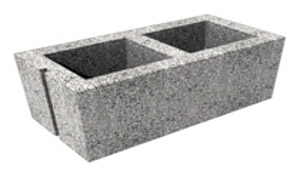Quality Masonry
Learning Objectives:
- Identify the factors that ensure sound energy and environmental performance in a single wythe wall.
- Explain the prevailing energy codes and their implications for continuous insulation and traditional wall assemblies .
- Discuss four lines of defense in preventing moisture intrusion in concrete masonry construction.
- Detail a successful single wythe project.
Credits:
Single wythe concrete masonry units (CMU) are a durable, cost-effective, aesthetically versatile form of masonry construction that has been widely used worldwide for decades. A sustainable, effective solution for owners and architects looking for permanence and low maintenance, single wythe construction is defined as a stone, brick, or concrete wall that is one masonry unit thick. A single wythe wall offers the economic advantage of serving as the structural system with multiple finish options on the exterior, and the interior as well. But as single wythe walls do not require the backup of a traditional cavity wall construction, in order to provide full protection from the elements they must be carefully detailed and constructed. This article will identify the factors that ensure proper performance and discuss the details and specifications that should be considered during the design process in order to achieve superior masonry buildings.
CMUs: What Are They?
Concrete masonry units are manufactured blocks used in construction. They come in a variety of sizes, colors, and finishes, the most common size being 8 inches deep by 8 inches tall by 16 inches long. They are generally comprised of sand, cement, stone or aggregate, and can have a color pigment such as iron oxide. Admixtures, such as integral water repellants, are also included to improve performance. CMUs are typically produced with hollow centers to reduce weight, with the added benefit of allowing insulation to be placed in the cores if specified.
 |
CMUs are large, rectangular blocks made of sand, cement, stone or aggregate, color pigment, and admixtures. Image courtesy of Jason Yana Studios, Inc. |
Wet and dry casting are the two most widely used methods today, with each requiring a unique mix of natural sands and aggregates. Wet cast concrete typically has 33 percent moisture content whereas in dry casting, there is 6 percent moisture content. The dry cast mix is consolidated by intense tamping with an air hammer until it is densely compacted and ready for removal from the mold. Dry-cast concrete has zero slump, and the forms can be stripped as soon as the concrete has been consolidated. After that, the concrete block is cured in an environment in which high humidity levels are maintained for at least 24 hours. A key benefit of this method is that only one set of forms is needed to mass produce a specific product, and the form can be stripped immediately.
The production of CMUs has progressed over the years from a one-at-a-time manufacturing process to a highly automated, state-of-the-art procedure. Inventors started developing concrete block right after the Revolutionary War. In 1832 the first concrete block was patented, but commercial success was found in England. Up until 1906, concrete block producers were experimenting with refining the manufacturing process. In this early hand tamp one-at-a-time machine, a workman would fill the machine with cement and aggregate, hand mixed on the ground. He would tamp the mix in and discharge the finished block. In 1915, block was produced from ash or cinders from coal, hence being known as “cinderblock.” By 1920, there were several thousand small plants producing 50 million CMU. Due to mechanization in 1941, 500 million units were being produced by fewer plants, and as of 2004, some 4.5 billion units were being produced by 600 companies in the U.S. The original tamping method has been replaced with vibration and compaction, and today's block machine produces 1,200 8-inch block equivalents per hour.
 |
Single wythe construction offers a time-tested solution that combines economy and aesthetics. Photo by Mike Butler |









